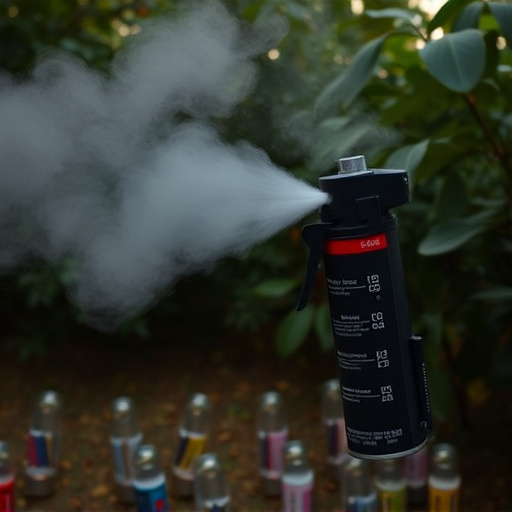When defending against dogs with pepper spray, choose products designed for animal deterrence with higher capsaicin concentrations and extended reach. Practice application techniques, aiming for eyes and face to temporarily disable the canine. Understand local laws and responsible use guidelines regarding pepper spray ownership and deployment as a last resort to ensure safety without causing harm to bystanders.
“Staying safe while facing potential threats, especially from aggressive dogs, is paramount. This article guides you through the essential aspects of using pepper spray as a self-defense weapon, focusing on its dynamics against dogs. We’ll explore how different types of pepper spray and proper application techniques can provide optimal protection. Additionally, we delve into legal considerations and responsible use guidelines to ensure your safety and well-being are always prioritized when carrying pepper spray for self-defense against dogs.”
- Understanding Pepper Spray Dynamics Against Dogs
- Choosing the Right Pepper Spray for Self Defense
- Effective Application Techniques for Optimal Protection
- Legal Considerations and Responsible Use Guidelines
Understanding Pepper Spray Dynamics Against Dogs
Pepper spray has established itself as a valuable tool for self-defense against humans, but its dynamics against dogs merit unique consideration. Unlike humans, dogs have more robust respiratory systems and thicker skin, which can affect the potency and effectiveness of pepper spray. Understandably, many traditional pepper spray formulations may not achieve the same level of incapacitation on canine targets as they do on humans.
When selecting a pepper spray for defense against dogs, focus on products designed specifically for animal deterrence. These formulas often contain higher concentrations of capsaicin, the active ingredient responsible for the burning sensation associated with pepper spray. Additionally, look for sprays with wider reach and stronger wind resistance to ensure maximum coverage, as dogs may try to avoid direct contact or blow the spray away.
Choosing the Right Pepper Spray for Self Defense
When selecting a pepper spray for self-defense, especially against dogs, it’s crucial to consider factors like strength and range. Look for sprays designed specifically for animal deterrence, as these often have higher concentrations of capsaicin—the active ingredient causing the burning sensation. A pepper spray with a reach of 20-30 feet gives you distance to assess and de-escalate situations, while still allowing for effective protection against aggressive dogs.
Additionally, familiarize yourself with local laws regarding pepper spray ownership and usage. Some areas have restrictions on the type and amount of pepper spray citizens can possess, as well as where it can be carried. Understanding these regulations ensures you’re using the right pepper spray not only effectively but also legally for self-defense against dogs or any other potential threats.
Effective Application Techniques for Optimal Protection
Effective application techniques are key to ensuring optimal protection when using pepper spray as a self-defense weapon, especially against dogs. Aim for the eyes and face—spraying directly into the animal’s eyes can temporarily blind it, creating an opening for you to escape. Move quickly and accurately; a swift, direct burst of spray is more effective than a prolonged misting.
Remember that range and angle matter. Keep a safe distance, typically 2–3 meters (6–10 feet), to avoid inhaling the pepper spray yourself. Angle the nozzle slightly downward to ensure maximum coverage on the target area without risking your safety or that of bystanders. Practice these techniques regularly to build confidence and refine your skills, ensuring you’re prepared for any potential encounter with a dog.
Legal Considerations and Responsible Use Guidelines
Before considering pepper spray as a self-defense weapon, it’s crucial to understand legal considerations and responsible use guidelines. Each jurisdiction has its own laws regarding the possession and use of pepper spray, so it’s essential to check local regulations to ensure compliance. For instance, some areas may restrict its use solely for law enforcement or have age restrictions on purchasing it. Additionally, understanding the legal implications of using pepper spray in self-defense against dogs is critical. While it can be a legitimate deterrent, misuse or improper application could lead to complications and potential lawsuits.
Responsible use guidelines dictate that pepper spray should only be deployed as a last resort when facing an imminent threat. Aim for eyes and face to maximize its effectiveness while minimizing harm to bystanders. Users must also be trained in safe handling practices, including proper storage and disposal methods. Responsible use ensures that pepper spray remains an effective tool for personal safety without causing unnecessary distress or injury.
When it comes to facing off against aggressive dogs, pepper spray can be a powerful self-defense tool. By understanding its dynamics, selecting the appropriate product, and mastering application techniques, individuals can ensure their safety while navigating potential dog encounters. Additionally, adhering to legal considerations and responsible use guidelines is paramount to protect oneself and others without causing undue harm. Equipped with this knowledge, folks can confidently navigate potential risks and foster a safer environment, making pepper spray a valuable addition to any personal defense arsenal for those facing Pepper Spray Defense Against Dogs.
